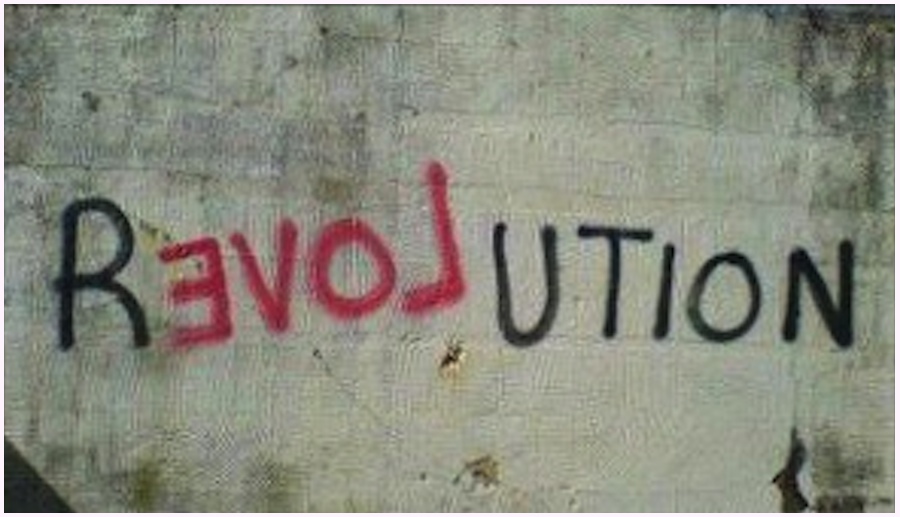Intermission: RLOVEUTION
- Details
- Hits: 8469
Above: the new Story of the People [ Story of Interbeing ]. Click on image to proceed.
"Once upon a time a great tribe of people lived in a world far away from ours. Whether far away in space, or in time, or even outside of time, we do not know. They lived in a state of enchantment and joy that few of us dare to believe could exist, except in those exceptional peak experiences when we glimpse the true potential of life and mind."
Charles Eisenstein, on page 268 - 269 of 'The More Beautiful World Our Hearts Know is Possible', published by North Atlantic Books, Berkeley, 2013
"A story is a sequence of related events that includes a [...] resolution. […] A narrative is a system of interrelated stories [ , ] a socio-cultural entity, and it serves a cognitive process of understanding and attention. Narratives […] operate as systems, both macro- and micro-, comprised of components such as stories, story forms, tropes, archetypes, and so forth. [ The ] vast array of cultural expression that circulates in a community or region is what we call the narrative landscape. [ A ] landscape includes specific features, such as trees, hills, and rivers, and these features all interact in an ecological system. [ L ] andscapes and their systems have characteristics [...] that influence how humans understand a locale and how they interact with it. The same is true with narrative landscapes: stories, narrative systems, and other forms of communication that enter into the narrative landscape interact with those already present. Literary theorist Mikhail Bakhtin describes this interactive quality when he explains: ["] Each utterance [story, narrative, communication, etc.] refutes, affirms, supplements, and relies upon the others, presupposes them to be known, and somehow takes them into account. ["] [N] arrative is a vehicle for ideology [ , ] humans make sense of the world through a narrative logic [ . ] [ In ] the narrative arc that governs most narrative systems, a conflict initiates a desire and a series of actions and participants, [...] toward a resolution [ . ]"
Scott W. Ruston and Jeffrey R. Halverson in 'VISUAL PROPAGANDA AND EXTREMISM IN THE ONLINE ENVIRONMENT', edited by Carol K. Winkler and Cori E. Dauber, chapter 5, page 112, 113, 114, 122, 124, first published in USA, Juli 2014 by Strategic Studies Institute and U.S. Army War College Press
"The best victory, says Sun Tzu, is the one in which the losers don't realize they have lost. In the old story, we overcome evil and leave our enemies in the dust, wailing and gnashing their teeth. No more. Everyone is coming along for his ride. In the new story, we understand that everyone left behind impoverishes the destination. We see each human being as the possessor of a unique lens upon the world. We wonder, "What truth has this man been able to see from his perspective, that is invisible from mine?" We know that there must be something; that indeed, each of us occupies a different place in the matrix of all being precisely in order to contribute a unique experience to our evolving totality."
Charles Eisenstein, on page 200 - 201 of 'The More Beautiful World Our Hearts Know is Possible', published by North Atlantic Books, Berkeley, 2013
"The screenwriting and directing workshops could take any shape […]. It was not about theory, […] everyone [was] presenting some ideas, […] we would all work together. […] I would bring students to the market [ telling them: ] first, you walk around the market, watching and listening but picking different angles, so that, for instance, instead of being the clients, you go to the side, and see as though you had put a camera behind the back of a vendor, see the rotting fruit he throws under the stall, the dogs going by, people misbehaving and so on. See what you usually don’t see. Then, note down everything that could happen in a film. That will take about three-quarters of an hour. Then we go back to school and there, the third step, you talk about what you have seen and heard. [...] Which is still different from the other two steps. And that often gave amazing results. Something that reality gives; how to see it, how to take it down, how to transmit it. That is an exciting exercise anyone can do anywhere, like I used to do with Tati and Pierre Etaix, sitting at a café. You simply look at people going by and you wonder what could happen, what could happen in a film, adapting it. It is not often and quite artificial, when reality can be inserted into a film."
Jean-Claude Carriere on 'Web of Stories' http://www.webofstories.com/play/jc.carriere/69;jsessionid=76FC291F95B079E22FFFC4553E103E3B
See also: http://bartvanbroekhoven.com/en-US/running/118-sar-act-2-2-3



